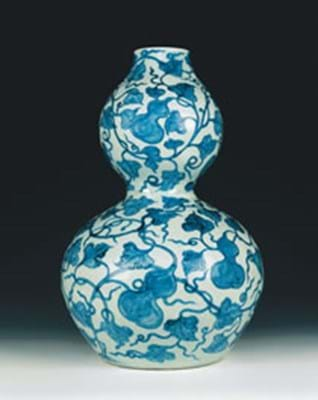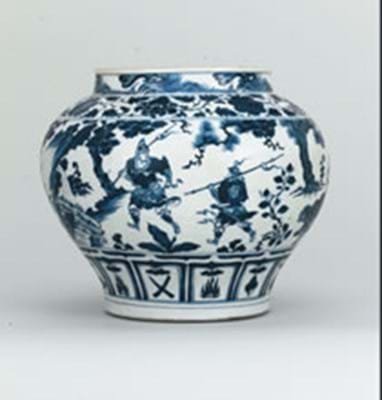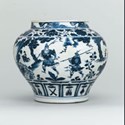Significantly, both were acquired by collectors in the early 20th century when they would have been purchased as Ming wares since scholars had not then identified and attributed a body of porcelain to this short-lived dynasty.
The London offering is the 13in (33cm) diameter jar or guan pictured bottom right, which is the star turn of Christie's Chinese ceramics and works of Art on July 12 with an unpublished estimate in excess of £1m.
Although any substantial piece of Yuan porcelain counts as rare, the particularly distinctive aspect of this jar is the painted central register of decoration featuring a continuous narrative scene rather than the usual more formalised motifs. Painted in a brilliant cobalt blue, this is a new addition to a rare group of seven other known jars all distinguished by finely executed narrative scenes from Yuan folk tales inspired by contemporary woodblock prints. Stylistic similarities in the more formal decorative motifs on this group to those on the famous vases in the Percival David collection dated 1351AD allow for a secure dating. The scene on Christie's guan depicts an episode in the conflict between the Yan and Qi States that took place over a thousand years earlier in the Warring States period, and the auctioneers have tracked down a very similar image in a woodblock print published between 1321 and 1323.
Importantly, it is also known when this guan left China for it was acquired there by the collector Captain Haro van Hemert tot Dingshof (1879-1972), who was stationed in Beijing with the Dutch Marine Corps from 1913-23. Christie's vendors, described in the catalogue as a European family, in turn acquired the guan directly from van Hemert.
Decoration is also the key and the talking point of the Salisbury offering, the 183/4in (47.5cm) double gourd vase pictured top right>/b>, which is the star of Woolley and Wallis's first sale devoted solely to Oriental works of art, scheduled for July 15. The gourd form is a favourite Oriental shape regarded as auspicious in China, but what singles this piece out is the highly naturalistic underglaze blue painting of a gourd vine which snakes from the bottom to the rim in a continuous coil. Such a naturalistic treatment coupled with the twinning of shape and decoration is highly unusual at this early date. Only one comparable but fragmentary example has been recorded. In 1994 Sotheby's London rooms offered the lower half only of a vase of the same period that carries very similar vine decoration but by a different hand.
Woolley and Wallis's vase is not only complete, it comes with a noted provenance. It belonged to William Cleverley Alexander (1840-1916), a connoisseur and collector of Oriental Art and Western Paintings whose collection featured Tang, Song, Ming and Ching wares, some of which are now in the British Museum. This vase has passed down by direct descent through his family. The Salisbury auction house are estimating it at £200,000-300,000 in their auction next month.
Anne Crane
Yuan dynasty blue and white porcelain has always been prized in some quarters but it is now generating much wider levels of interest.
The July sales of Asian art will be notable for bringing two newly discovered pieces to the market, one in London and the other in Salisbury.








